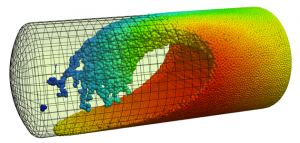CFD analysis roadblocks
The structure and most common roadblocks of CFD analysis are outlined in this article.
The structure and most common roadblocks of CFD analysis are outlined in this article.
Computational Fluid Dynamics (CFD) is the process of describing flow of fluid through or around structures. Read this article for more on CFD fundamentals. For many engineers CFD is a bit of a black box; we know we need this to determine loads on our structures, but to get these results with sufficient accuracy requires us to venture outside our safe zone of structural statics and dynamics. Often, we’d rather estimate it using much simplified formulas.
Mostly because we suddenly have to solve for a different set of equations, with material behaving not at all like the trusted steel and aluminium we are used to. This is due in part to the fact that all fluid dynamics is inherently non-linear, with a non-negligible second order term in our system of equations. Next to the non-linear issue we have three other roadblocks we want to lay out for you.
Turbulence
Turbulence is the cause of a lot of troubles in CFD calculations. To solve this, many models have been designed, giving a relation between the flow and the (viscous) energy dissipation. These models, however, tend to work best for specific cases and worse, badly for others. Which turbulence model to choose is therefore an important step, based on an initial guess.
 The size of the mesh
The size of the mesh
Another reason for hesitation is the size of the models created. While FEA is usually measured in minutes, CFD tends to require very small elements for turbulence and tends to require hours, days or even months depending on how complicated the construction is and how detailed the mesh needs to be to describe the smallest details.
The convergence of the solution
The third reason for hesitation is the convergence of the solution. Far more than in FEA, where convergence is sometimes an issue with complicated simulations including contact and the like, the convergence of CFD analyses depends on mesh size, element shape, geometry and flow conditions. Two meshes with similar meshing parameters might not converge in the same fashion.
This problem is the worst in explicit solvers, since these are only conditionally stable in the first place, requiring a (very) small time step. Implicit solvers do not have this problem, but inverting the matrix of these huge models requires large amounts of computing power.
Once all these hurdles are taken, the analyses can be used to compute the velocity and pressure fields. With these fields the drag and lift on the surfaces can be determined, as well as geometry quantities as the aerodynamic center. Now we can finally return to the safe embrace of structural engineering.
Did you like this post? Sign up for our newsletter and we’ll send you more posts like this every month.
If you need any help with your CFD calculations or need advice on CFD software tools, the specialists of Femto Engineering will be glad to help you.
Teaming up with us means you can count on our extensive consulting expertise in FEA and CFD. We have a reliable and flexible team that can work alongside you to fulfill your engineering objectives.
The software you use should get the job done. The analysis and simulation solutions from our Partner, Siemens PLM Software will do just that. We offer advice, support and training too.
Through research and innovation, we support our clients to be at the forefront of new technology. This is why we invest in R&D and work closely with industry leading research institutes and universities.
Do you need more information or want to discuss your project? Reach out to us anytime and we’ll happily answer your questions.
At Femto Engineering we help companies achieve their innovation ambitions with engineering consultancy, software, and R&D.
We are Siemens DISW Expert Partner for Simcenter Femap, Simcenter 3D, Simcenter Amesim, Simcenter STAR-CCM+ and SDC verifier. Get in touch and let us make CAE work for you.
Sign up for our newsletter to get free resources, news and updates monthly in your inbox. Share in our expertise!